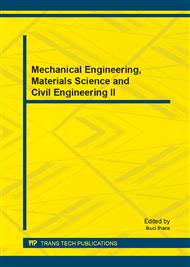p.267
p.271
p.275
p.280
p.284
p.289
p.293
p.298
p.304
Numerical Analysis of the Effect of Roadside Accumulated Water on Subgrade Temperature Field in the Freezing Region
Abstract:
The change of moisture-heat is the key factor that influences the seasonal freezing subgrade stability. In order to analyze the impact of the moisture on temperature field in the seasonal frozen subgrade, this paper established seasonal freezing subgrade model, calculated and analyzed the effects of subgrade temperature field in the middle of road, shoulder, slope and outside of slope with roadside accumulated water, based on the change of temperature field control equation. This research showed that roadside accumulated water has a significant influence on the subgrade temperature field. The results showed the range of 0°C isotherm under the accumulated water was bigger than normal subgrade, and the depth of 0°C isotherm was deeper under the accumulated water than normal.
Info:
Periodical:
Pages:
284-288
Citation:
Online since:
December 2013
Authors:
Price:
Сopyright:
© 2014 Trans Tech Publications Ltd. All Rights Reserved
Share:
Citation:


